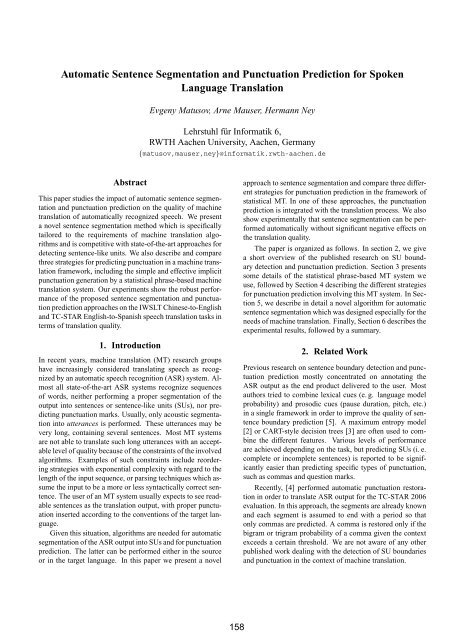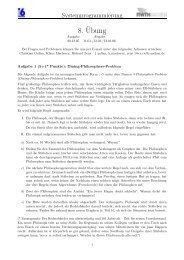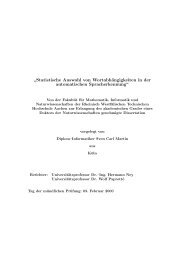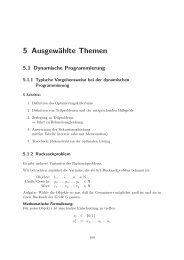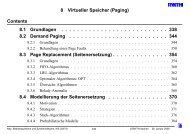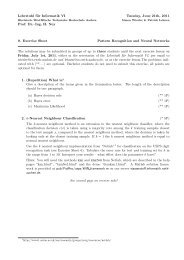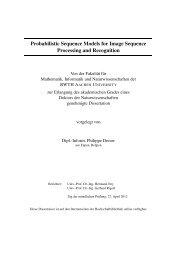Automatic Sentence Segmentation and Punctuation Prediction for ...
Automatic Sentence Segmentation and Punctuation Prediction for ...
Automatic Sentence Segmentation and Punctuation Prediction for ...
You also want an ePaper? Increase the reach of your titles
YUMPU automatically turns print PDFs into web optimized ePapers that Google loves.
<strong>Automatic</strong> <strong>Sentence</strong> <strong>Segmentation</strong> <strong>and</strong> <strong>Punctuation</strong> <strong>Prediction</strong> <strong>for</strong> Spoken<br />
Language Translation<br />
Evgeny Matusov, Arne Mauser, Hermann Ney<br />
Lehrstuhl für In<strong>for</strong>matik 6,<br />
RWTH Aachen University, Aachen, Germany<br />
{matusov,mauser,ney}@in<strong>for</strong>matik.rwth-aachen.de<br />
Abstract<br />
This paper studies the impact of automatic sentence segmentation<br />
<strong>and</strong> punctuation prediction on the quality of machine<br />
translation of automatically recognized speech. We present<br />
a novel sentence segmentation method which is specifically<br />
tailored to the requirements of machine translation algorithms<br />
<strong>and</strong> is competitive with state-of-the-art approaches <strong>for</strong><br />
detecting sentence-like units. We also describe <strong>and</strong> compare<br />
three strategies <strong>for</strong> predicting punctuation in a machine translation<br />
framework, including the simple <strong>and</strong> effective implicit<br />
punctuation generation by a statistical phrase-based machine<br />
translation system. Our experiments show the robust per<strong>for</strong>mance<br />
of the proposed sentence segmentation <strong>and</strong> punctuation<br />
prediction approaches on the IWSLT Chinese-to-English<br />
<strong>and</strong> TC-STAR English-to-Spanish speech translation tasks in<br />
terms of translation quality.<br />
1. Introduction<br />
In recent years, machine translation (MT) research groups<br />
have increasingly considered translating speech as recognized<br />
by an automatic speech recognition (ASR) system. Almost<br />
all state-of-the-art ASR systems recognize sequences<br />
of words, neither per<strong>for</strong>ming a proper segmentation of the<br />
output into sentences or sentence-like units (SUs), nor predicting<br />
punctuation marks. Usually, only acoustic segmentation<br />
into utterances is per<strong>for</strong>med. These utterances may be<br />
very long, containing several sentences. Most MT systems<br />
are not able to translate such long utterances with an acceptable<br />
level of quality because of the constraints of the involved<br />
algorithms. Examples of such constraints include reordering<br />
strategies with exponential complexity with regard to the<br />
length of the input sequence, or parsing techniques which assume<br />
the input to be a more or less syntactically correct sentence.<br />
The user of an MT system usually expects to see readable<br />
sentences as the translation output, with proper punctuation<br />
inserted according to the conventions of the target language.<br />
Given this situation, algorithms are needed <strong>for</strong> automatic<br />
segmentation of the ASR output into SUs <strong>and</strong> <strong>for</strong> punctuation<br />
prediction. The latter can be per<strong>for</strong>med either in the source<br />
or in the target language. In this paper we present a novel<br />
approach to sentence segmentation <strong>and</strong> compare three different<br />
strategies <strong>for</strong> punctuation prediction in the framework of<br />
statistical MT. In one of these approaches, the punctuation<br />
prediction is integrated with the translation process. We also<br />
show experimentally that sentence segmentation can be per<strong>for</strong>med<br />
automatically without significant negative effects on<br />
the translation quality.<br />
The paper is organized as follows. In section 2, we give<br />
a short overview of the published research on SU boundary<br />
detection <strong>and</strong> punctuation prediction. Section 3 presents<br />
some details of the statistical phrase-based MT system we<br />
use, followed by Section 4 describing the different strategies<br />
<strong>for</strong> punctuation prediction involving this MT system. In Section<br />
5, we describe in detail a novel algorithm <strong>for</strong> automatic<br />
sentence segmentation which was designed especially <strong>for</strong> the<br />
needs of machine translation. Finally, Section 6 describes the<br />
experimental results, followed by a summary.<br />
2. Related Work<br />
Previous research on sentence boundary detection <strong>and</strong> punctuation<br />
prediction mostly concentrated on annotating the<br />
ASR output as the end product delivered to the user. Most<br />
authors tried to combine lexical cues (e. g. language model<br />
probability) <strong>and</strong> prosodic cues (pause duration, pitch, etc.)<br />
in a single framework in order to improve the quality of sentence<br />
boundary prediction [5]. A maximum entropy model<br />
[2] or CART-style decision trees [3] are often used to combine<br />
the different features. Various levels of per<strong>for</strong>mance<br />
are achieved depending on the task, but predicting SUs (i. e.<br />
complete or incomplete sentences) is reported to be significantly<br />
easier than predicting specific types of punctuation,<br />
such as commas <strong>and</strong> question marks.<br />
Recently, [4] per<strong>for</strong>med automatic punctuation restoration<br />
in order to translate ASR output <strong>for</strong> the TC-STAR 2006<br />
evaluation. In this approach, the segments are already known<br />
<strong>and</strong> each segment is assumed to end with a period so that<br />
only commas are predicted. A comma is restored only if the<br />
bigram or trigram probability of a comma given the context<br />
exceeds a certain threshold. We are not aware of any other<br />
published work dealing with the detection of SU boundaries<br />
<strong>and</strong> punctuation in the context of machine translation.
3. Phrase-based MT system of RWTH<br />
In this section we will briefly present the statistical MT system<br />
which we use in the experiments <strong>for</strong> this work. We<br />
will denote the (given) source sentence with f1 J = f 1 . . . f J ,<br />
which is to be translated into a target language sentence<br />
e I 1 = e 1 . . . e I .<br />
Our baseline system maximizes the translation probability<br />
directly using a log-linear model [9]:<br />
p(e I 1|f J 1 ) =<br />
( ∑M<br />
)<br />
exp<br />
m=1 λ mh m (e I 1, f1 J )<br />
∑ ( ∑M<br />
) , (1)<br />
exp<br />
m=1 λ mh m (ẽ I 1 , f 1 J) ẽ I 1<br />
speech<br />
ASR<br />
SUs<br />
SUs<br />
SUs<br />
SUs +<br />
punctuation<br />
MT1<br />
MT2<br />
MT3<br />
wann sagten Sie wann sagten Sie wann, sagten Sie,<br />
wird es besser wird es besser wird es besser?<br />
when did you say<br />
it will be better<br />
SU boundary<br />
detection<br />
when, did you say,<br />
will it be better?<br />
source<br />
language<br />
punctuation<br />
prediction<br />
when, did you say,<br />
will it be better?<br />
with a set of different features h m , scaling factors λ m <strong>and</strong> the<br />
denominator a normalization factor that can be ignored in the<br />
maximization process. We choose the λ m by optimizing an<br />
MT per<strong>for</strong>mance measure on a development corpus using the<br />
downhill simplex algorithm.<br />
The most important models in equation (1) are phrasebased<br />
models in both source to target <strong>and</strong> target to source<br />
directions. In order to extract these models, an alignment<br />
between a source sentence <strong>and</strong> its target language translation<br />
is found <strong>for</strong> all sentence pairs in the training corpus using<br />
the IBM-1, HMM <strong>and</strong> IBM-4 models in both directions<br />
<strong>and</strong> combining the two obtained alignments [10]. Given this<br />
alignment, an extraction of contiguous phrases is carried out<br />
<strong>and</strong> their probabilities are computed by means of relative frequencies<br />
[13].<br />
Additionally we use single word based lexica in source<br />
to target <strong>and</strong> target to source direction. This has the effect<br />
of smoothing the relative frequencies used as estimates of<br />
the phrase probabilities. The phrase-based <strong>and</strong> single word<br />
based probabilities thus yield 4 features of the log-linear<br />
model. Another important feature in the log-linear model is<br />
the language model, an n-gram language model with Kneser-<br />
Ney smoothing. A length <strong>and</strong> a phrase penalty are the last<br />
models in the set of the seven basic models which are used<br />
in the system.<br />
4. <strong>Sentence</strong> <strong>Segmentation</strong> <strong>and</strong> <strong>Punctuation</strong><br />
<strong>Prediction</strong> in an MT framework<br />
The issue of sentence segmentation arises when translating<br />
ASR output. It is important to produce translations of sentences<br />
or sentence-like units to make the MT output humanreadable.<br />
At the same time, sophisticated speech translation<br />
algorithms (e. g. ASR word lattice translation, rescoring <strong>and</strong><br />
system combination algorithms <strong>for</strong> (N-best) output of one or<br />
several SMT systems) may require that the number of words<br />
in the input source language SUs is limited to about 30 or 40<br />
words.<br />
Figure 1 depicts three alternative strategies <strong>for</strong> predicting<br />
segment boundaries <strong>and</strong> punctuation in the process of machine<br />
translation of automatically recognized speech. We<br />
have investigated each strategy in our experiments. In all<br />
target language<br />
punctuation<br />
prediction<br />
Figure 1: Three different strategies <strong>for</strong> predicting punctuation<br />
in the process of speech recognition <strong>and</strong> machine translation.<br />
three cases, we begin by taking the raw output of an ASR system,<br />
which is a long sequence of words. The sentence segmentation<br />
algorithm, which will be described in Section 5, is<br />
applied to produce sentence-like units of the length acceptable<br />
both to humans <strong>and</strong> as input to an MT system.<br />
Although it is possible to predict punctuation marks in<br />
an unsegmented text <strong>and</strong> then use the automatically inserted<br />
periods, question marks, <strong>and</strong> exclamation marks as segment<br />
boundaries, our experiments show that this approach leads<br />
to poor segmentation results. It is much easier to predict a<br />
segment boundary (considering lexical <strong>and</strong> also prosodic features<br />
like the pause length) than to predict whether a specific<br />
punctuation mark has to be inserted or not at a given word position<br />
in the transcript. In the context of machine translation,<br />
separating sentence segmentation <strong>and</strong> punctuation prediction<br />
also allows <strong>for</strong> more flexible processing of the determined<br />
segments. Here, we are interested in having proper punctuation<br />
in the target language translation <strong>and</strong> thus may want to<br />
predict punctuation marks in the target language, where the<br />
rules <strong>and</strong> conventions <strong>for</strong> punctuation may be different from<br />
the source language.<br />
Starting by per<strong>for</strong>ming sentence segmentation of the<br />
ASR output in the source language, we followed three different<br />
approaches with the goal of having punctuation in<br />
the target language translations (Figure 1). For each of the<br />
approaches, we extracted three different types of bilingual<br />
phrase pairs based on the same word alignment between the<br />
bilingual sentence pairs in the training data. Thus, three MT<br />
systems were created. They will be described in the following<br />
subsections.
4.1. Phrase-based MT without <strong>Punctuation</strong> Marks<br />
In the first system MT 1 we removed punctuation marks from<br />
the source <strong>and</strong> the target training corpus, adjusting the indices<br />
of the alignment accordingly. Thus, the phrases extracted<br />
using the modified training corpora <strong>and</strong> alignment do<br />
not contain punctuation marks. With this system, the target<br />
language translation of the ASR output also does not contain<br />
punctuation marks. <strong>Punctuation</strong> marks have to be inserted<br />
based on the lexical context in the automatically produced<br />
translation, e.g. using a hidden-event target language model<br />
<strong>and</strong> the method of [12].<br />
The advantage of this method is the possibility to optimize<br />
the parameters of the MT system with the goal of improving<br />
the lexical choice independent of any punctuation<br />
marks. Also, the absence of punctuation marks allows <strong>for</strong><br />
better generalization <strong>and</strong> longer matches of bilingual phrase<br />
pairs (see also Section 4.3).<br />
One drawback of the approach is that the punctuation<br />
marks then have to be predicted using only language model<br />
in<strong>for</strong>mation. Moreover, this prediction is per<strong>for</strong>med on the<br />
translation hypotheses which may contain errors with respect<br />
to both word choice <strong>and</strong> word order. In the current state of<br />
technology, these errors are much more numerous than the<br />
speech recognition errors. The presence of these errors may<br />
result in poor quality of the automatically predicted punctuation.<br />
Another drawback is that any prosodic features which<br />
are characteristic to a certain punctuation type (e.g. the pitch<br />
at the end of a question) cannot be directly used in the target<br />
language punctuation prediction. Transferring these features<br />
as the annotation of the translation hypothesis may be possible,<br />
but is complicated due to the reordering per<strong>for</strong>med in<br />
MT.<br />
4.2. Implicit <strong>Punctuation</strong> Mark <strong>Prediction</strong> in the MT<br />
process<br />
The second system MT 2 was created by removing punctuation<br />
marks only from each source language training sentence,<br />
together with their alignment connections to the words in the<br />
corresponding target sentence. Thus, the punctuation marks<br />
in the target sentence which had been aligned with punctuation<br />
marks in the source sentence became non-aligned.<br />
Next, in the phrase extraction phase, <strong>for</strong> the same sequence of<br />
words followed or preceded by a punctuation mark, two different<br />
phrase pairs were extracted, one containing the target<br />
phrase with the punctuation mark, <strong>and</strong> one with the punctuation<br />
mark omitted from the target phrase. In the example in<br />
Figure 1, this would mean that e. g. <strong>for</strong> the phrase sagten<br />
Sie the MT system would memorize four translations:<br />
did you say<br />
, did you say<br />
did you say ,<br />
, did you say ,<br />
With this heuristic, target phrases with punctuation marks<br />
compete with phrases without punctuation marks in the<br />
search, <strong>and</strong> the language model <strong>and</strong> other features help to select<br />
the best hypothesis (see Section 3). It is also possible to<br />
optimize the scaling factors of the models involved in the MT<br />
system to obtain the best translation per<strong>for</strong>mance as measured<br />
using reference translations with punctuation marks.<br />
This aspect makes the approach more robust than the one<br />
where punctuation marks are predicted using only the target<br />
language model, in a postprocessing step. In practical terms,<br />
this implicit approach is easy to use, since it requires neither<br />
preprocessing nor postprocessing with respect to punctuation.<br />
This is especially of advantage when taking alternative<br />
ASR hypotheses (e. g. ASR word lattices) as input <strong>for</strong><br />
MT.<br />
Alternatively, the systems MT 1 <strong>and</strong> MT 2 can be trained<br />
“from scratch” by removing punctuation marks from the<br />
source <strong>and</strong> target training corpora or only the source training<br />
corpus, respectively, <strong>and</strong> then per<strong>for</strong>ming the word alignment<br />
training <strong>and</strong> phrase extraction. This may improve the<br />
alignment estimation, especially <strong>for</strong> small training corpora.<br />
4.3. Phrase-based MT with <strong>Punctuation</strong> Marks<br />
Finally, <strong>for</strong> the system MT 3 the phrase pairs were extracted<br />
including punctuation marks both in the source <strong>and</strong> the target<br />
training corpus.<br />
Generally, a system like MT 3 can be a st<strong>and</strong>ard system<br />
<strong>for</strong> translating written text input with correctly placed punctuation<br />
marks. In order to use this system <strong>for</strong> the ASR output,<br />
the punctuation has to be predicted in the source language.<br />
This is a good strategy if prosodic features are used<br />
to improve the per<strong>for</strong>mance of the punctuation prediction algorithm.<br />
However, if the punctuation prediction algorithm is<br />
not robust enough <strong>and</strong> makes many errors, this may have a<br />
significant negative effect on the machine translation quality.<br />
For instance, long source phrases with good translations may<br />
not match the input due to an extra or missing comma, so that<br />
shorter phrases will have to be used, with a negative influence<br />
on the fluency <strong>and</strong> adequacy of the produced translation.<br />
Nowadays, leading MT systems are capable of translating<br />
ASR word lattices with alternative ASR hypotheses in<br />
order to overcome the negative impact of speech recognition<br />
errors. Using the system MT 3 <strong>for</strong> lattice translation would<br />
mean that punctuation will have to be predicted within a lattice.<br />
This is a non-trivial problem, <strong>for</strong> which an efficient <strong>and</strong><br />
robust solution is hard to find. Thus, the system MT 3 is<br />
probably not suitable <strong>for</strong> processing ASR word lattices.<br />
Another disadvantage of this system originates in the<br />
differences in punctuation rules <strong>and</strong> conventions between<br />
languages, which make the task of translating punctuation<br />
marks from the source to the target language a very ambiguous<br />
one. For example, some commas in Chinese are not<br />
translated into English. Also, the M<strong>and</strong>arin language has two<br />
types of commas which have to be either omitted in translation<br />
or translated to the ASCII comma in English, etc. Due<br />
to this ambiguity, the translation of punctuation marks is not<br />
error-free. Thus, we cannot expect much better per<strong>for</strong>mance
of MT 3 which translates punctuation marks than of the system<br />
MT 2 which inserts punctuation marks in the translation<br />
process.<br />
5. Novel <strong>Sentence</strong> <strong>Segmentation</strong> Algorithm<br />
State-of-the-art approaches to sentence segmentation treat<br />
segment boundaries as hidden events. A posterior probability<br />
<strong>for</strong> a possible boundary after a word is determined <strong>for</strong><br />
each word position. Then, the boundaries are determined by<br />
selecting only those positions, <strong>for</strong> which the posterior probability<br />
of a segment boundary exceeds a certain threshold.<br />
This means that although the segmentation granularity can<br />
be controlled, the length of a segment may take any value<br />
from 1 to several hundred words. This may be a disadvantage<br />
<strong>for</strong> further processing of the segmented transcript, which<br />
may require the sentence units to be at least m <strong>and</strong>/or at most<br />
M words long.<br />
Our approach to segmentation of ASR output originates<br />
from the work of [12] <strong>and</strong> thus also uses the concept of<br />
hidden events to represent the segment boundaries. A decision<br />
regarding the placement of a segment boundary is<br />
made based on a log-linear combination of language model<br />
<strong>and</strong> prosodic features. However, in contrast to existing approaches,<br />
we optimize over the length of each segment (in<br />
words) <strong>and</strong> add an explicit segment length model. Thus, we<br />
per<strong>for</strong>m HMM-style search with explicit optimization over<br />
the length of a segment. A similar approach to topic segmentation<br />
was presented by [7]. Such an approach makes it possible<br />
to introduce restrictions on the minimum <strong>and</strong> maximum<br />
length of a segment, <strong>and</strong> nevertheless produce syntactically<br />
<strong>and</strong> semantically meaningful sentence units which pass all<br />
the relevant context in<strong>for</strong>mation on to the phrase-based MT<br />
system.<br />
In the following we present the details of the approach.<br />
We are given an (automatic) transcription of speech, denoted<br />
by the words w1<br />
N := w 1 , w 2 , . . . , w N . We would like to<br />
find the optimal segmentation of this word sequence into K<br />
segments, denoted by i K 1 := (i 1 , i 2 , . . . , i K = N). Among<br />
all the possible segmentations, we will choose the one with<br />
the highest posterior probability:<br />
î ˆK<br />
1 = argmax<br />
K,i K 1<br />
{<br />
P r(i<br />
K<br />
1 |w N 1 ) } (2)<br />
The posterior probability P r(i K 1 |w N 1 ) is modeled directly using<br />
a log-linear combination of several models:<br />
P r(i K 1 |w N 1 ) =<br />
( ∑M<br />
)<br />
exp<br />
m=1 λ mh m (i K 1 , w1 N )<br />
∑ ( ∑M<br />
)<br />
exp<br />
m=1 λ mh m (i ′ K ′<br />
1 , w1 N) K ′ ,i ′K′<br />
1<br />
(3)<br />
The denominator is a normalization factor that depends only<br />
on the word sequence w N 1 . There<strong>for</strong>e, we can omit it during<br />
the search process. As a decision rule, we obtain:<br />
{<br />
∑ M<br />
}<br />
î ˆK<br />
1 = argmax<br />
K,i K 1<br />
λ m h m (i K 1 , w1 N )<br />
5.1. Feature functions<br />
m=1<br />
In practice, the features used in Eq. 4 depend on the words<br />
within the hypothesized adjacent boundaries at position i :=<br />
i k−1 <strong>and</strong> at position j := i k as well as on the prosodic in<strong>for</strong>mation<br />
at the boundary i. To compute probabilities <strong>for</strong> a<br />
hypothesized segment w j i+1 starting with word position i + 1<br />
<strong>and</strong> ending at position j, we interpolate log-linearly the following<br />
probabilistic features.<br />
The language model probability p LM (w j i+1 ) <strong>for</strong> a segment<br />
is computed as a product of the following three probabilities:<br />
p LM (w j i+1 ) = p S(w j i+1 ) · p I(w j i+1 ) · p E(w j i+1 )<br />
These probabilities are modeled as described below (assuming<br />
a trigram language model):<br />
(4)<br />
• probability of the first two words of a segment (segment<br />
Start), conditioned on the last segment boundary<br />
represented by a hidden event :<br />
p S (w j i+1 ) = p(w i+1|) · p(w i+2 |w i+1 , )<br />
• probability of the other words within a segment<br />
(Internal probability):<br />
p I (w j i+1 ) =<br />
j∏<br />
k=i+3<br />
p(w k |w k−1 , w k−2 )<br />
• LM probability of the segment boundary (End) in dependency<br />
on the last two words of a segment:<br />
p E (w j i+1 ) = p(|w j, w j−1 )<br />
The probabilities are integrated into the log-linear model by<br />
using the negative logarithm of the corresponding probability<br />
value as a feature value. The extension to a larger (e. g. 4-<br />
gram) context is straight<strong>for</strong>ward.<br />
In addition to the language model probability, we use a<br />
prosodic feature, namely the normalized pause duration between<br />
the words w i <strong>and</strong> w i+1 located directly be<strong>for</strong>e <strong>and</strong> after<br />
the hypothesized boundary. For the normalization, the<br />
probability of a segment boundary is set to 1 if the pause is<br />
10 or more seconds long. Other prosodic features can be included<br />
with a separate scaling factor, assuming that they also<br />
provide a single (posterior) probability <strong>for</strong> a segment boundary<br />
at each word position.<br />
Since the length of the segment is known, we also include<br />
an explicit sentence length probability feature − log p(j−i).<br />
We usually estimate this distribution on the corpus used to estimate<br />
the source language model. We chose the log-normal
distribution <strong>for</strong> sentence length modeling, because it reflects<br />
the actual length histogram most accurately. The parameters<br />
of this distribution were determined using maximum likelihood<br />
estimation.<br />
We also include a segment penalty h SP (i K 1 , w N 1 ) = K<br />
in the log-linear combination. This is a simple heuristic that<br />
helps to additionally control the segmentation granularity. If<br />
the scaling factor λ SP of this model is negative, generally<br />
more segments are produced because more segments reduce<br />
the total cost of the segmentation. Similarly, <strong>for</strong> λ SP > 0, in<br />
general fewer segments are produced by the presented algorithm.<br />
The scaling factors in the log-linear combination of the<br />
presented models are currently tuned manually on a development<br />
set by computing precision <strong>and</strong> recall with respect to<br />
human reference SUs.<br />
5.2. Search<br />
In search, the word sequence w1<br />
N is processed from left to<br />
right. For all hypothesized segment end positions j, we optimize<br />
over the position of the last segment boundary i <strong>and</strong> calculate<br />
the loglinear combination of the scores <strong>for</strong> the segment<br />
w j i+1 as described above. The optimal sentence segmentation<br />
solution <strong>for</strong> words up to position i has already been computed<br />
in a previous recursion step <strong>and</strong> is added to the score <strong>for</strong> the<br />
current segment. The globally optimal sentence segmentation<br />
<strong>for</strong> the document is determined when the last word of<br />
the document is reached.<br />
Note that the minimum <strong>and</strong>/or maximum sentence<br />
lengths l <strong>and</strong> L can be explicitly set by limiting the values<br />
of i to l ≤ j − i ≤ L. Since usually the maximum length L<br />
does not exceed 50 or 60 words, the algorithm is rather fast:<br />
e.g. 30 000 words are segmented in less than a second.<br />
6.1. Evaluation Criteria<br />
6. Experimental Results<br />
To evaluate the quality of the sentence segmentation algorithm<br />
as described in Section 5, we compute precision <strong>and</strong><br />
recall in comparison to the sentence boundaries defined by<br />
humans. In case of ASR output, the reference boundaries are<br />
inserted in the automatically produced transcript by aligning<br />
it with the correct (reference) transcript with the minimum<br />
edit distance algorithm.<br />
The quality of machine translation is evaluated with objective<br />
error <strong>and</strong> correctness measures. These measures compare<br />
the MT output against human reference translations.<br />
We use the common metrics BLEU, NIST, WER, <strong>and</strong> PER.<br />
BLEU [11] <strong>and</strong> NIST [1] are correctness measures based on<br />
the similarity of subsequences of MT output <strong>and</strong> reference<br />
translation. The word error rate WER measures the word<br />
insertions, deletions <strong>and</strong> substitutions between the automatic<br />
translation <strong>and</strong> the reference. The position-independent word<br />
error rate PER computes the distance between the sets of<br />
words contained in MT output <strong>and</strong> reference translation.<br />
Table 1: Quality of sentence segmentation measured with<br />
Precision (P) <strong>and</strong> Recall (R) in % <strong>for</strong> the TC-STAR English<br />
ASR output (minimum sentence length set to 3, maximum to<br />
50 words).<br />
Development Test<br />
P R P R<br />
baseline (4-gram LM only) 54.2 52.1 54.0 50.4<br />
+ length model 54.7 52.5 55.3 51.7<br />
+ pause model 68.8 68.4 70.5 69.7<br />
baseline + pause model 68.1 68.3 69.9 70.3<br />
When translating ASR output with automatic sentence<br />
segmentation, the number of automatically determined segments<br />
may be different from the number of segments in the<br />
human reference translations. In this case, we use the tool<br />
of [6] to determine the alignment with the multiple reference<br />
translations based on the word error rate <strong>and</strong>, using this alignment,<br />
to re-segment the translation output to match the number<br />
of reference segments. Then, the usual MT evaluation<br />
measures are computed.<br />
6.2. Quality of sentence segmentation<br />
The experiments <strong>for</strong> automatic sentence segmentation were<br />
per<strong>for</strong>med <strong>for</strong> the TC-STAR task <strong>and</strong> <strong>for</strong> the IWSLT task.<br />
For the TC-STAR task (speech recognition <strong>and</strong> translation of<br />
Speeches in the European Parliament), we determined sentence<br />
boundaries in the English ASR output <strong>for</strong> the 2006<br />
English-to-Spanish Speech Translation evaluation. The ASR<br />
word error rate (WER) was 6.9%. The scaling factors of the<br />
models involved, as well as the minimum <strong>and</strong> maximum segment<br />
length parameters, were tuned manually on the development<br />
set (with about 28K words <strong>and</strong> 1194 segments in the<br />
verbatim (correct) transcription) with the goal of increasing<br />
<strong>and</strong> balancing precision <strong>and</strong> recall. Then, these scaling factors<br />
were used <strong>for</strong> detecting segment boundaries in the evaluation<br />
set (with about 28K words <strong>and</strong> 1155 segments in the<br />
verbatim transcription). The precision <strong>and</strong> recall percentages<br />
<strong>for</strong> the development <strong>and</strong> test set are given in Table 1.<br />
The baseline system <strong>for</strong> sentence segmentation only<br />
made use of a 4-gram language model trained on the English<br />
part of the European Parliament corpus (over 31 million<br />
words). The parametric sentence length model was also estimated<br />
on this data. The largest gains in per<strong>for</strong>mance came<br />
from using the pause duration feature, which indicates that<br />
in many cases the speakers do make pauses to mark the start<br />
of a new sentence. The best segmentation results reach 70%<br />
precision <strong>and</strong> recall.<br />
Further experiments were per<strong>for</strong>med on the IWSLT<br />
Chinese-to-English task (2006 evaluation). This task consisted<br />
of translating manually <strong>and</strong> automatically transcribed<br />
utterances related to tourism from Chinese to English. For
Table 2: Quality of sentence segmentation measured with<br />
Precision (P) <strong>and</strong> Recall (R) in % <strong>for</strong> the IWSLT Chinese-<br />
English task (minimum sentence length set to 3, maximum<br />
to 30 words). Comparison of the RWTH approach with the<br />
st<strong>and</strong>ard approach of SRI [5]. No prosodic features are used.<br />
RWTH tool hidden-ngram<br />
corpus P R P R<br />
IWSLT test 2005 84.2 84.1 84.1 85.5<br />
IWSLT dev 2006 59.5 64.6 57.0 62.4<br />
IWSLT test 2006 56.4 61.0 54.9 57.6<br />
IWSLT test 2006 (ASR) 56.0 55.2 55.4 52.6<br />
this task, we did not use the pause duration feature, since all<br />
of the utterances had been recorded separately. Instead, we<br />
compared the per<strong>for</strong>mance of the algorithm across different<br />
types of data. The 2005 test set with 3208 words <strong>and</strong> 506 reference<br />
segments is very similar to the training data (around<br />
300K words) on which the 4-gram LM was trained, whereas<br />
the 2006 test set with 5550 words <strong>and</strong> 500 segments contains<br />
more spontaneous utterances. We were also interested in the<br />
effect of speech recognition errors on sentence segmentation.<br />
The Chinese character error rate was 12.8% <strong>for</strong> the development<br />
set <strong>and</strong> 15.2% <strong>for</strong> the test set.<br />
Table 2 gives an overview of the segmentation results <strong>for</strong><br />
this task. The system per<strong>for</strong>ms very well on the 2005 test<br />
data, but not as well on the more spontaneous data. The ASR<br />
errors mostly affect recall, presumably because some of the<br />
words which are typical <strong>for</strong> the beginning or the end of a<br />
sentence had not been recognized correctly.<br />
These results are better than or comparable to the wellestablished<br />
approach of SRI [12] using the same language<br />
model (cf. the last two columns of Table 2. For the experiments<br />
with the SRI toolkit, the threshold <strong>for</strong> the SU posterior<br />
probability was optimized <strong>for</strong> precision/recall on the same<br />
development set.<br />
6.3. Translation quality<br />
Even though we can measure the per<strong>for</strong>mance of the sentence<br />
segmentation algorithm in terms of precision <strong>and</strong> recall<br />
of the found segment boundaries, it is not clear how automatic<br />
segmentation <strong>and</strong> punctuation prediction affect the<br />
quality of machine translation output. There<strong>for</strong>e we evaluated<br />
the different ways of segmentation <strong>and</strong> punctuation<br />
restoration in a machine translation setup.<br />
As <strong>for</strong> evaluating the quality of the segmentation, we use<br />
the TC-STAR 2006 English-to-Spanish <strong>and</strong> the IWSLT 2006<br />
Chinese-to-English tasks <strong>and</strong> compare our results to the evaluation<br />
submissions. For these experiments, only single-pass<br />
search was used, i. e. no rescoring of N-best lists with additional<br />
models was per<strong>for</strong>med.<br />
The results shown in Table 3 show the effect of the various<br />
types of segmentation <strong>and</strong> punctuation restoration. The<br />
label “implicit“ refers to the system where punctuation is<br />
added implicitly in the translation process, as described in<br />
Section 4.2. The labels “source” <strong>and</strong> “target” name the setups,<br />
where punctuation is inserted in the source language or<br />
in the target language, respectively. The MT systems <strong>for</strong><br />
these set-ups were trained as described in Sections 4.3 <strong>and</strong><br />
4.1, respectively. All MT systems were optimized with respect<br />
to the BLEU measure on a development set.<br />
For punctuation prediction either in the source or in the<br />
target language we used the hidden-ngram tool from the<br />
SRI toolkit [12]. We used a 4-gram hidden event language<br />
model trained as proposed by the organizers of the IWSLT<br />
2006 evaluation.<br />
When indicated, automatic segmentation of the ASR output<br />
was used. As an overall baseline, we used the translation<br />
of the correct transcription. There, we have no recognition<br />
errors <strong>and</strong> manual segmentation of the input. In order to separate<br />
the effects of ASR errors <strong>and</strong> segmentation, we aligned<br />
the ASR output with the correct transcription (with removed<br />
punctuation) using edit distance in order to obtain the original<br />
segmentation.<br />
From Table 3 it becomes clear that recognition errors<br />
account <strong>for</strong> the most of the loss in translation quality as<br />
compared to the translation of the correct transcription. In<br />
contrast, the MT evaluation measures only degrade slightly<br />
when automatic segmentation is used <strong>and</strong> the punctuation is<br />
automatically predicted. This shows that the presented approaches<br />
to SU boundary detection <strong>and</strong> punctuation restoration<br />
are robust enough to be used in a machine translation<br />
framework. The restriction on the maximum sentence length<br />
(50 words) allows <strong>for</strong> efficient translation. On the other h<strong>and</strong>,<br />
the restriction on the minimum sentence length of 3 words<br />
helps to avoid breaking apart word groups, <strong>for</strong> which a good<br />
phrasal translation exists. <strong>Sentence</strong>s shorter than 3 words<br />
are usually st<strong>and</strong>ard expressions like “yes” <strong>and</strong> “thank you”,<br />
which are translated accurately even if they become part of a<br />
longer segment.<br />
All strategies <strong>for</strong> predicting punctuation marks work similarly<br />
well <strong>for</strong> this task, with the best translation results<br />
yielded by inserting punctuation marks in the source language.<br />
This can be explained by the low recognition error<br />
rate on this corpus, which makes punctuation prediction in<br />
the source language sufficiently reliable.<br />
A preliminary version of the proposed segmentation algorithm<br />
was already used by all participants in the 2006 TC-<br />
STAR evaluation [8].<br />
For the IWSLT 2006 experiments, the results shown in<br />
Table 4 indicate a similar tendency as the results <strong>for</strong> the TC-<br />
STAR task. Errors introduced by automatic speech recognition<br />
have a higher impact on the translation scores than the<br />
errors introduced from automatic segmentation.<br />
With respect to translation quality, the best per<strong>for</strong>mance<br />
with punctuation is achieved by implicit prediction using the<br />
translation model. This method has the advantage that the<br />
per<strong>for</strong>mance of the phrase-based translation system is not de-
Table 3: Translation quality <strong>for</strong> the TC-STAR English-to-Spanish task.<br />
transcription segmentation punctuation prediction BLEU [%] WER [%] PER [%] NIST<br />
correct correct manual (source) 45.2 43.3 32.2 9.71<br />
automatic correct (aligned) source 37.8 50.6 37.6 8.77<br />
automatic source 36.7 51.2 38.1 8.70<br />
implicit 36.1 51.5 38.6 8.62<br />
target 36.3 51.3 38.4 8.66<br />
full stop only (source) 35.8 50.2 38.6 8.70<br />
Table 4: Translation quality <strong>for</strong> the IWSLT 2006 Chinese-to-English task. All scores are computed case-sensitive with punctuation,<br />
as in the official evaluation. The reference translations <strong>for</strong> the 2006 evaluation data were not available. There<strong>for</strong>e, scores<br />
using automatic segmentation can only be reported <strong>for</strong> the development set.<br />
transcription segmentation punctuation prediction BLEU [%] WER [%] PER [%] NIST<br />
DEV 2006<br />
correct correct source 19.8 70.5 54.3 5.99<br />
implicit 22.0 71.0 53.0 5.86<br />
target 18.9 70.7 55.2 6.03<br />
automatic source 17.3 66.1 54.9 5.34<br />
implicit 20.7 62.1 52.0 5.41<br />
target 17.5 67.2 55.9 5.49<br />
automatic correct source 15.9 73.9 58.5 5.28<br />
implicit 19.0 69.1 56.7 5.18<br />
target 15.4 73.2 58.2 5.37<br />
automatic source 14.4 68.4 58.2 4.51<br />
implicit 17.1 64.8 55.2 4.62<br />
target 13.8 69.0 59.1 4.60<br />
TEST 2006<br />
correct correct source 18.5 71.7 55.1 5.39<br />
implicit 21.0 67.1 54.5 5.13<br />
target 17.7 70.7 55.1 5.38<br />
automatic correct source 15.7 73.6 58.8 4.82<br />
implicit 17.8 70.2 57.8 4.57<br />
target 15.2 73.6 59.7 4.78<br />
teriorated by falsely inserted punctuation marks in the source<br />
side. This is especially important in the IWSLT task, since<br />
the corpus is small. Furthermore, the translation quality of<br />
the overall system including punctuation prediction is optimized<br />
as a whole. On the small task, using the translation<br />
model <strong>and</strong> the target language model in combination to generate<br />
punctuation on the target side can improve system per<strong>for</strong>mance.<br />
7. Conclusions<br />
We presented a framework <strong>for</strong> automatic detection of<br />
sentence-like units <strong>and</strong> punctuation prediction in the context<br />
of statistical spoken language translation.<br />
The novel sentence segmentation method presented here<br />
per<strong>for</strong>med at least as well as the state-of-the-art approaches<br />
in terms of precision <strong>and</strong> recall, but has the advantage that the<br />
length of the produced segments can be explicitly controlled<br />
<strong>and</strong> adjusted to the needs of machine translation algorithms.<br />
The robustness of the proposed method was also confirmed<br />
when evaluating it in terms of the resulting machine translation<br />
quality.<br />
For punctuation prediction, we compared three different<br />
approaches:<br />
• translating input without punctuation marks followed<br />
by punctuation prediction on the resulting translations<br />
in a postprocessing step,<br />
• implicitly generating punctuation marks in the translation<br />
process, <strong>and</strong><br />
• predicting punctuation in the MT input <strong>and</strong> translating
with an MT system trained on a fully punctuated corpus.<br />
We discussed the advantages <strong>and</strong> disadvantages of each<br />
strategy <strong>and</strong> per<strong>for</strong>med a contrastive evaluation on two translation<br />
tasks. For the large vocabulary task of the TC-STAR<br />
English-to-Spanish evaluation, punctuation prediction in the<br />
MT input yields best translation quality. For the small vocabulary<br />
2006 IWSLT Chinese-to-English task, implicit generation<br />
of punctuation marks leads to superior translation quality.<br />
In the future, we would like to investigate a tighter coupling<br />
of automatic SU <strong>and</strong> punctuation prediction <strong>and</strong> machine<br />
translation by considering “soft” segment boundaries.<br />
8. Acknowledgements<br />
This work was in part funded by the European Union under<br />
the integrated project TC-STAR – Technology <strong>and</strong> Corpora<br />
<strong>for</strong> Speech to Speech Translation (IST-2002-FP6-506738)<br />
<strong>and</strong> is partly based upon work supported by the Defense Advanced<br />
Research Projects Agency (DARPA) under Contract<br />
No. HR0011-06-C-0023. Any opinions, findings <strong>and</strong> conclusions<br />
or recommendations expressed in this material are<br />
those of the authors <strong>and</strong> do not necessarily reflect the views<br />
of the DARPA.<br />
9. References<br />
[1] Doddington, G. “<strong>Automatic</strong> Evaluation of Machine<br />
Translation Quality Using N-gram Co-Occurrence<br />
Statistics”. In Proc. ARPA Workshop on Human Language<br />
Technology, San Diego, Cali<strong>for</strong>nia, March 2002.<br />
[2] Huang, J., <strong>and</strong> Zweig, G. “Maximum entropy model<br />
<strong>for</strong> punctuation annotation from speech”. In Proc. of<br />
ICSLP, pp. 917-920, 2002.<br />
[3] Kim, J., <strong>and</strong> Woodl<strong>and</strong>, P. “The use of prosody in<br />
a combined system <strong>for</strong> punctuation generation <strong>and</strong><br />
speech recognition”. In Proc. of Eurospeech, pp. 2757-<br />
2760, 2001.<br />
[7] Matusov, E., Peters, J., Meyer, C., <strong>and</strong> Ney, H.<br />
“Topic <strong>Segmentation</strong> Using Markov Models on Section<br />
Level”. In Proceedings of the 8th IEEE <strong>Automatic</strong><br />
Speech Recognition <strong>and</strong> Underst<strong>and</strong>ing Workshop<br />
(ASRU 2003), St. Thomas, Virgin Isl<strong>and</strong>s, USA,<br />
pp. 471-476, December 2003.<br />
[8] Matusov, E., Zens, R., Vilar, D. Mauser, A., Popovic,<br />
M., <strong>and</strong> Ney, H. “The RWTH Machine Translation System”.<br />
In Proc. of The 2006 TC-STAR Workshop on<br />
Speech-to-Speech Translation, pp. 31-36, Barcelona,<br />
Spain, June 2006.<br />
[9] Och, F. J., <strong>and</strong> Ney, H. “Discriminative training <strong>and</strong><br />
maximum entropy models <strong>for</strong> statistical machine translation.”<br />
In Proc. of the 40th Annual Meeting of the Association<br />
<strong>for</strong> Computational Linguistics (ACL), pp. 295-<br />
302, Philadelphia, PA, July 2002.<br />
[10] Och, F. J., <strong>and</strong> Ney, H. “A systematic comparison of<br />
various statistical alignment models.” Computational<br />
Linguistics, 29(1):19–51, March 2003.<br />
[11] K. Papineni, S. Roukos, T. Ward, <strong>and</strong> W.-J. Zhu, “Bleu:<br />
a method <strong>for</strong> automatic evaluation of machine translation,”<br />
in Proc. of the 40th Annual Meeting of the Association<br />
<strong>for</strong> Computational Linguistics (ACL), Philadelphia,<br />
PA, July 2002, pp. 311–318.<br />
[12] Stolcke, A., Shriberg, E., Bates, R., Ostendorf, M.,<br />
Hakkani, D., Plauche, M., Tür, G. <strong>and</strong> Lu, Y., “<strong>Automatic</strong><br />
detection of sentence boundaries <strong>and</strong> disfluencies<br />
based on recognized words,” In Proc. of ICSLP ’98, International<br />
Conf. on Spoken Language Processing, pp.<br />
2247-2250, Sidney, Australia, 1998.<br />
[13] Zens, R., <strong>and</strong> Ney, H. “Improvements in phrase-based<br />
statistical machine translation.” In Proc. Human Language<br />
Technology Conf. / North American Chapter of<br />
the Association <strong>for</strong> Computational Linguistics Annual<br />
Meeting (HLT-NAACL), pp. 257-264, Boston, MA,<br />
May 2004.<br />
[4] Lee, Y., Al-Onaizan, Y., Papineni, K., <strong>and</strong> Roukos, S.<br />
“IBM Spoken Language Translation System”. In Proc.<br />
TC-STAR Workshop on Speech-to-Speech Translation,<br />
pp. 13-18, Barcelona, Spain, June 2006.<br />
[5] Liu, Y., Shriberg, E., Stolcke, A., Hillard, D., Ostendorf,<br />
M., Peskin, B., <strong>and</strong> Harper, M. “The ICSI-SRI-<br />
UW Metadata Extraction System,” ICSLP 2004, International<br />
Conf. on Spoken Language Processing, Korea,<br />
2004.<br />
[6] Matusov, E., Leusch, G., Bender, O., <strong>and</strong> Ney, H.<br />
“Evaluating Machine Translation Output with <strong>Automatic</strong><br />
<strong>Sentence</strong> <strong>Segmentation</strong>”. In Proc. of IWSLT<br />
2005, pp. 148-154, Pittsburgh, PA, October 2005.


